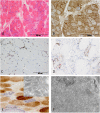Biomarkers in Inflammatory Myopathies-An Expanded Definition
- PMID: 31214105
- PMCID: PMC6558048
- DOI: 10.3389/fneur.2019.00554
Biomarkers in Inflammatory Myopathies-An Expanded Definition
Abstract
Biomarkers as parameters of pathophysiological conditions can be of outmost relevance for inflammatory myopathies. They are particularly warranted to inform about diagnostic, prognostic, and therapeutic questions. As biomarkers become more and more relevant in daily routine, this review focusses on relevant aspects particularly addressing myopathological features. However, the level of evidence to use them in daily routine at presence is low, still since none of them has been validated in large cohorts of patients and rarely in independent biopsy series. Hence, they should be read as mere expert opinions. The evaluation of biomarkers as well as key biological parameters is an ongoing process, and we start learning about relevance of them, as we must recognize that pathophysiology of myositis is biologically incompletely understood. As such this approach should be considered an essay toward expansion of the definition "biomarker" to myositis, an emerging field of interest in biomedical research.
Keywords: DM; IBM; IIM; IMNM; biomarker; morphology; myositis; myositis-specific-autoantibodies.
Figures





References
-
- Troyanov Y, Targoff IN, Tremblay JL, Goulet JR, Raymond Y, Senecal JL. Novel classification of idiopathic inflammatory myopathies based on overlap syndrome features and autoantibodies: analysis of 100 French Canadian patients. Medicine. (2005) 84:231–49. 10.1097/01.md.0000173991.74008.b0 - DOI - PubMed
-
- Lundberg IE, Tjarnlund A, Bottai M, Werth VP, Pilkington C, de Visser M, et al. . 2017 European League Against Rheumatism/American College of Rheumatology Classification Criteria for Adult and Juvenile Idiopathic Inflammatory Myopathies and Their Major Subgroups. Arthritis Rheumatol. (2017) 69:2271–82. 10.1002/art.40320 - DOI - PMC - PubMed
-
- Lundberg IE, Tjarnlund A, Bottai M, Werth VP, Pilkington C, de Visser M, et al. . 2017 European League Against Rheumatism/American College of Rheumatology classification criteria for adult and juvenile idiopathic inflammatory myopathies and their major subgroups. Ann Rheum Dis. (2017) 76:1955–64. 10.1136/annrheumdis-2017-211468 - DOI - PMC - PubMed
Publication types
LinkOut - more resources
Full Text Sources
Research Materials

